MLK, Jr. Viaduct
Introduction
Text-to-speech Audio
What was once known only as "The Viaduct," and often in a derogatory tone, is now the Dr. Martin Luther King, Jr. Memorial Viaduct, and a commemoration of his work to bring people together with the words "I Have a Dream" emblazoned over the center of Main Street. And while the viaduct now calls out for that dream, the structure itself has a heritage that includes a dream fulfilled, a nightmare event, and a murky haze of decline that hung over it for several decades in the mid-20th century. With it's replacement 40+ years ago, and its reimagining as one of the largest historical markers anywhere, it fills a new role as a sign of hope for our future.
Images
Viaduct loaded with people as Company K went off to the Spanish American War
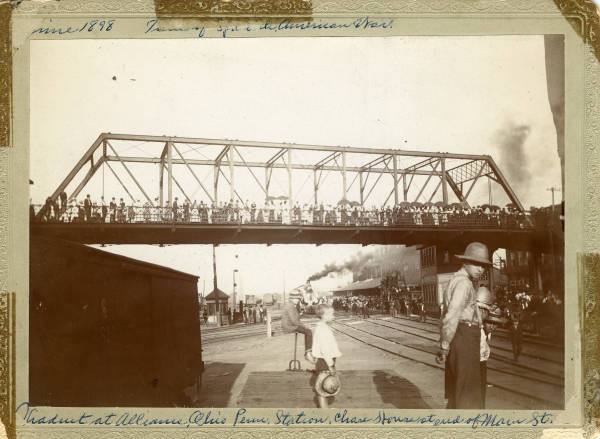
Viaduct loaded with people as Company K went off to the Spanish American War
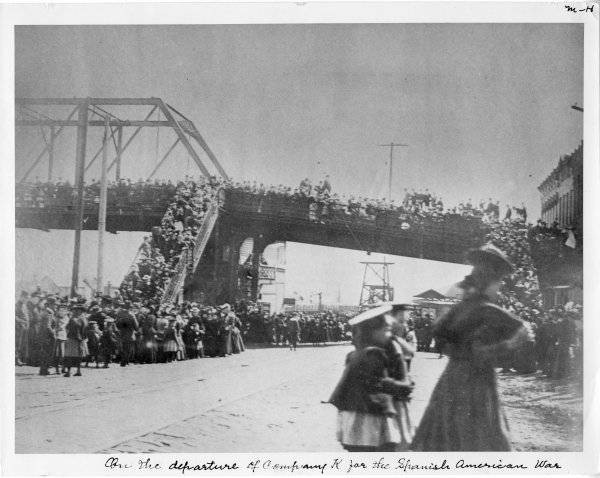
Martin Luther King, Jr. Viaduct, 2022
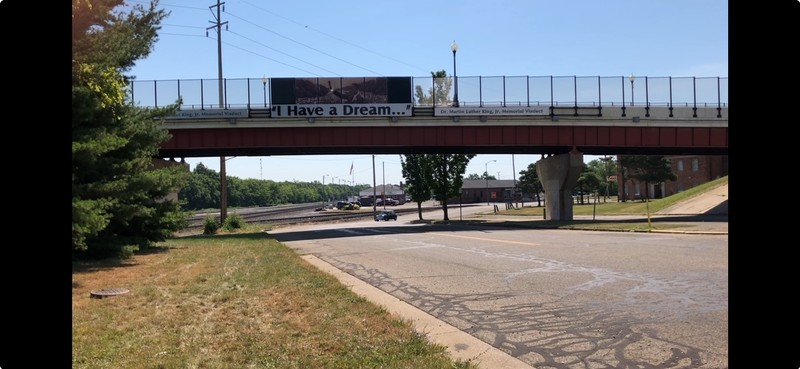
The McKinley Funeral Train passed through Alliance en-route to Canton on September 18, 1901. The track over which the train passed was strewn with flowers. The scene presented in this picture is at the crossing of the Pennsylvania Lines, the P., Ft. W. & C. and the C & P., at the Union Depot. The banner appears to read "WE MOURN FOR OUR NATIONS DEAD HIS LIFES WORK IS OUR ENDURING HERITAGE".
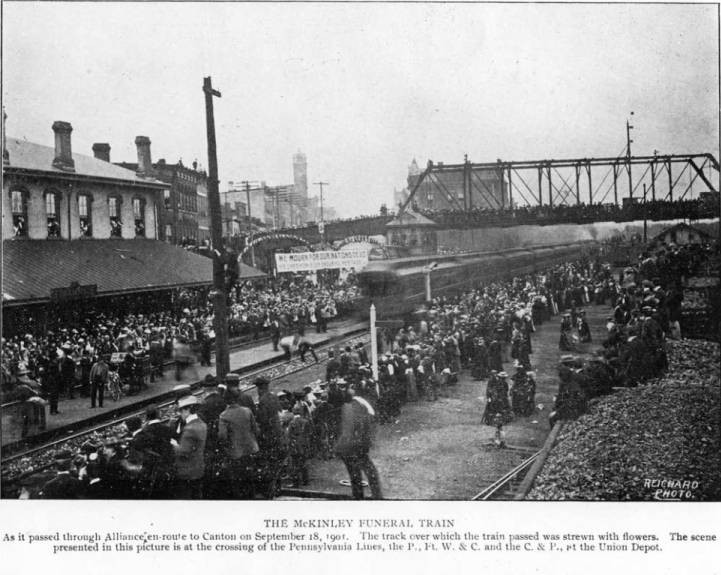
2021 Unity Walk crossing over the MLK Viaduct
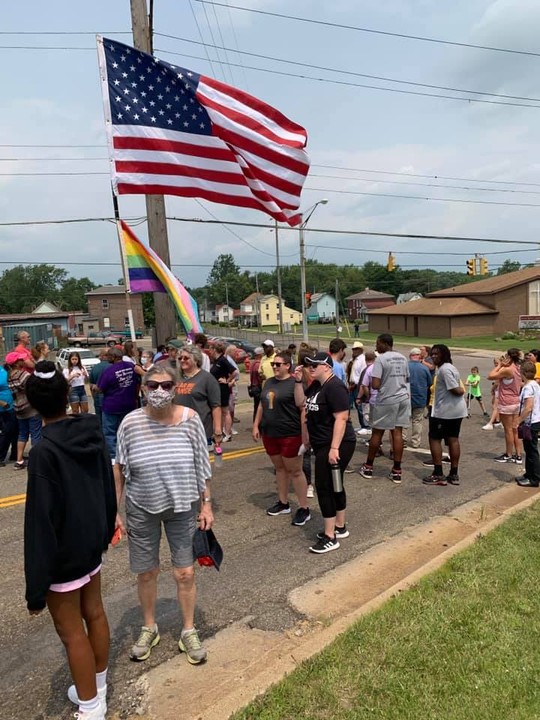
Viaduct Unity Walk 2022

Backstory and Context
Text-to-speech Audio
By the 1890s, traffic growth on the two rails lines and the growth of the Alliance community brought ongoing tensions to a head. The station and roundhouse grounds had grown to bursting, and could not expand because of the industry and housing that had grown up around it. The Pennsylvania Railroad (still operating its lines as the C&P and the PFW&C) began acquiring land between Union Avenue and Rockhill Road in order to build out what had previously been modest auxiliary switching yards. These new western yards were limited however by the crossing of tracks at Lincoln Avenue and Rockhill, and the PRR sought to have those streets vacated and the full right of way returned to the railroad. At the same time, congestion strangled traffic to and from the north and east of downtown at the railroad station. The City had already been talking with the PRR for over a decade about building a viaduct over the company’s tracks between Liberty and Webb Streets.
Several years of negotiation finally led to an agreement in 1894 which would close the two western streets for the railroad’s west side yards and in return the railroad would construct the steel superstructure and supports for viaducts over the tracks near the station, and another one at Lincoln. The city was required to secure all property needed and construct the approaches at both sites. Within two years the downtown viaduct was built, and traffic flowed more freely around and through the station and downtown. However, due to the outcry of west side residents and businesses, Lincoln Ave was never vacated, and the viaduct there never constructed, much to the chagrin of the Pennsylvania Railroad.
A few years later, the station and viaduct were the site of a scene, repeated across America, as the local company of Army volunteers set off for the Spanish-American War. In April 1898, much of the community came to the station to bid goodbye to its sons, members of the National Guard’s 8th Ohio Volunteer Infantry, Company K. They had mustered at on the hill above downtown at the new Methodist Church and marched down Freedom Avenue to Main Street and onto the Pennsylvania Railroad Union Depot to the cheers of thousands, much like those that cheered Lincoln on his way to his inauguration. Three years later, a similarly-size crowd would wish a farewell to William McKinley as the martyred President’s funeral train passed slowly through town on the way to his resting place in nearby Canton.
On September 4, 1906 a daytime nightmare occured when a switching engine lost control of a box car which left the track running into the north abutment of the Viaduct, cause the northern end of the bridge structure to collapse on the track. The accident killed Cleveland and Pittsburgh flagman Clarence Kreshner, and shut down the tracks for over a day. Though the Pennsylvania Railroad promised a rebuilt span in 7 months, due to construction delays, authority for what work needed to be done and who would pay, it was not until mid-May 1909 when the new Viaduct was opened.
By the time of the Great Depression, the economic peril, the aging depot and decline of passenger traffic led to the area around the viaduct becoming an increasingly rundown place. As the north end of the structure led to a neighborhood facing serious challenges and decline, an increase in crime followed, and the viaduct, and the railroad station became an entirely different place than it had been for Alliances first one hundred years—the gateway to the bigger world.
By the 1970s, the structural integrity of the Viaduct was again called into question, and in 1975 and 1976, a new concrete bridge, designed for contemporary auto and railroad traffic was built. A revitalization project for the Viaduct, and a rechristening was spearheaded by the Martin Luther King Steering Committee, a local community action group which led to the creation the commemorative display and naming for the new Dr. Martin Luther King, Jr. Memorial Viaduct. Repair to the structure and road bed with enhanced lighting, fencing and safety features were all a part of this $1.6 million project.
Cite This Entry
Historical Society, Alliance. "MLK, Jr. Viaduct." Clio: Your Guide to History. June 21, 2024. Accessed April 3, 2025. https://theclio.com/entry/177063
Sources
City of Alliance, Ohio, “Minutes of Council Meeting for January 6, 1879,” accessed February 2, 2020, http://www.cityofalliance.com/Archive.aspx?ADID=196
Church, S. L., Corporate History of the Pennsylvania Lines West, Philadelphia, PA: The Pennsylvania Company, pp 729-731.
“Contracts May Retain Penna. Shops,” Alliance Review, August 12, 1917, p. 1.
Rodman Public Library. “On the departure of Company K for the Spanish American War,” Alliance Memory. Accessed April 7, 2020. https://www.alliancememory.org/digital/collection/places/id/2/rec/1.
Pages from Alliance History, As Printed in The Alliance Review, 1940-1941, Alliance: Alliance Historical Society, 1946, p. 34.
Rodman Public Library. “The McKinley Funeral Train,” Alliance Memory. Accessed April 7, 2020. https://www.alliancememory.org/digital/collection/places/id/1409/rec/1.
"Work resuming on MLK Viaduct," March 23, 2011 Review, The (Alliance, OH) Stephanie Ujhelyi
https://www.alliancememory.org/digital/collection/places/id/95/
https://www.alliancememory.org/digital/collection/places/id/2/
Alliance Historical Society. Photograph by Karen Perone.
https://www.alliancememory.org/digital/collection/places/id/1409/rec/21
https://www.facebook.com/YWCAofAlliance/photos/pb.100064830365258.-2207520000/4461681823852069/?type=3
https://www.facebook.com/events/1092386328014434/?ref=newsfeed

